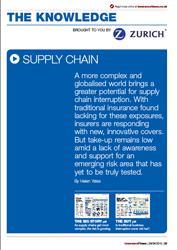Zurich Insurance global supply chain product leader, global corporate, Nick Wildgoose puts risk under the microscope and looks at how to banish those supply chain jitters
How big a threat is supply chain risk to companies today? According to Zurich’s research with the Business Continuity Institute, 64% of SMEs are less likely to have business continuity arrangements for supply chain disruptions than large companies (76%), even though the number of UK SMEs relying on global suppliers has increased.
It’s important that businesses and their brokers consider how to manage such risks. Insurance offers one option for risk transfer and today’s insurance options are offering broader coverage. But supply chain risk is often overlooked and undervalued – according to Zurich’s 2014 Supply Chain Resilience Survey, 73.5% of companies don’t monitor the total cost of supply chain disruption, making it difficult for them to quantify the true impact, meaning there could be significant hidden costs to organisations.
Broking in a world of risk
Brokers need to be aware of emerging risks and understand the products available to customers, including an understanding of compliance regulation, which affects companies worldwide. For example, the government is consulting on the UK Slavery Act, which demands that UK-based firms know whether there is an instance of slavery in their supply chain, either locally or globally. This will apply to organisations with a turnover exceeding a minimum threshold.
From a global perspective, companies trading with or having key suppliers in higher risk locations need to reassess their situation because of the threats such locations can pose to their supply chain. For example, companies that have relocated any part of their operations to, or own subsidiaries in the Asia-Pacific region face potential supply chain disruption through heightened flood and weather risks.
The key word here is transparency: having a clear picture of the potential risks affecting customers and suppliers in higher risk locations. Companies with the best supply chain risk management strategies know precisely where key suppliers are located – they can monitor their sites, set up news or google alerts and follow social media for details of local industrial and political unrest, aiding risk mitigation strategies. It’s also important that suppliers agree to notify companies of events that could disrupt the chain.
More locally, IT failures or hacking attacks, port closures through industrial action or lack of capacity for the larger container vessels, and manufacturer shut-downs through a supplier’s breach of regulations (for example the horse meat scandal) are all possible interruptions to a well-functioning supply chain.
Risk under the microscope
Zurich’s strategic risk management consultant, risk engineering UK, Alan Ross outlines the important questions in a supply chain health check (www.zurich.co.uk/SupplyChainHealthcheck) that brokers and customers need to consider:
- Does the customer have a clear understanding of their key suppliers?
- To understand the level of risk and resilience in the supply chain, what is the company’s key product/service delivering the most revenue and value?
- Is the company collecting data about disruption so as to quantify its cost, such as increased transportation costs, downtime or overtime?
- What is the level of exposure with a particular supplier or customer?
- What resilience measures have been planned and put in place? For example, buffer stocks or dual sourcing to meet any supply shortfall.
The answers to these questions can help customers test whether they have a good understanding and control over their risks, and whether there are gaps that need addressing. To help do this you can use readily available tools to help understand and map out supply chain risks. Zurich’s supply chain risk assessment product is a consultancy service that helps companies go through this process with the assistance of ready-to-deploy, pre-built methods.
To try Zurich’s supply chain health check and for the latest insights, practical expertise and to accumulate CII CPD learning hours, visit www.insider.zurich.co.uk and follow us on Twitter @ZurichInsider
World Economic Forum (WEF) – annual Global Risk Report
The WEF’s Global Risk Report is a must-read for any companies wanting to understand present and future global risks. This year’s report highlights the areas of greatest concern, including conflicts between states such as that involving Ukraine and Russia, major water crises, failure of climate change adaptation, cyber attacks and unemployment/under-employment.
Zurich/Business Continuity Institute report 2014
• 73.5% of companies don’t have full visibility of their supply chains
• 81% experienced at least one instance of supply chain disruption
• The primary causes of supply disruption were unplanned IT/telecommunications outages (53%), weather (52%) and outsourced service failures (36%), which caused loss of productivity for 58.5%, increased cost of working for 47.5% and loss of revenue for 45%







































No comments yet